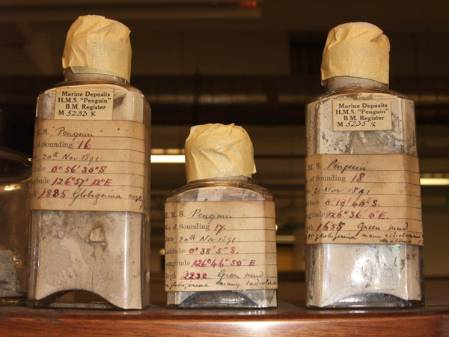The quick answer is anything from less than one pence to several thousands of pounds. The value of a specimen depends on a number of factors; market value, recollection value, as well as its historical and scientifical significance. Valuations are needed for insurance purposes before we loan specimens for exhibitions or to scientists. Here are some thoughts on how to put a monetary value on microfossils.
- Why value?
When I first came to the Museum I was told that we don’t do valuations. I sometimes had to stand in for the enquiries officer and usually someone would phone up or come in with a specimen and ask us 'how much is it worth?' or 'would we like to buy it'? Saying that we didn't do valuations was a convenient policy to maintain a consistent approach.
Things have changed and now, before we loan for exhibitions or for any other reason, we do a valuation because the loanee is required to provide insurance during the loan period.
Occasionally colleagues visit professional dealer fairs where specimens are for sale and need to know what is a good price before buying new specimens.
Sometimes it is important to remind funding bodies about the value of the collections in our care. If you place a completely arbitrary figure of £20 on each specimen in our department, the contents of our building is worth an estimated £180 million!
- Is there a market value?
I didn’t think there was a market for microfossils. However, a recent Google search threw up a banner on the right hand side saying ‘Buy Microfossils’. Of course I couldn’t resist following the link and found that you can buy a whole jar of sand including literally thousands of microfossils for £1.49 – significantly less than one pence per individual specimen.
A recent search on eBay found that you can buy examples of the microfossil Nummulites for 99p.The two examples I have given are for items that are very common. What if the specimens are less easy to replace?
- How easy is it to find another one?
One way to put a valuation on a microfossil is to work out how much it would cost to collect another one. If taken literally this could place enormous values on specimens, for example - it would cost millions of pounds to drill another offshore oil well.
I recently had to value some slides for an exhibition at the Gasworks Gallery that had been collected from the Antarctic Ocean. The temptation was to calculate how much it would cost to mount a new trip there to find more material. However, other trips to the same area have been carried out since then so we should be able to source equivalent material. The valuation therefore took into account obtaining these residues and paying a technician to make up new slides.
This makes it important to record details of collecting costs when participating in fieldwork so that valuations can be carried out more easily. This should take into account time spent in the laboratory and cost of consumables like chemicals used. As a result, it would be relatively easy to value of each slide created by Tim Potter from our field trip to the Welsh Borderland.
Sometimes collecting sites may no longer exist because they have become overgrown or are inaccessible for other reasons. In these instances, additional value can be assigned to these specimens.
Some species in the £1.49 jar of microfossils may be 10 to a penny but for others there may be only one example in the jar. Time taken for an expert to look through the residue under a microscope and provide an identification should also be built into any valuation in this instance. A rare specimen in this jar may well be worth far more than £1.49 as a result.
Some bottles rich in microfossils from the Ocean Bottom Residue Collection. The material cannot be collected again, has historical significance and is certainly worth a great deal more than £1.49. An individual specimen on a slide derived from one of these residues may not be worth as much as we can easily find a replacement from these bottles.
- How does the history of a specimen affect its value?
Some specimens have considerable historical value as they were collected by famous scientists. As a rule of thumb, valuations are roughly doubled in these instances. Some leeway is needed here. If a 1p microfossil had been collected by Darwin, clearly it would be worth a bit more than 2p!
- What is its scientific significance?
Type specimens will obviously be worth more than others. Other specimens that may not have been published can also have added value. For example, we have some specimens from boreholes drilled when they were exploring the site of the channel tunnel. These have added scientific and historical value.
Although it is sad for me to think that some of my specimens are worth less than one pence, there are many in the collection that are worth much more based on replacement value. A fine example is to consider the billions of pounds that BP must have spent acquiring the microfossil collection that we now hold.
If you see microfossils or microfossil collections for sale, I'd love to hear from you. This can help me to provide accurate valuations in the future.



